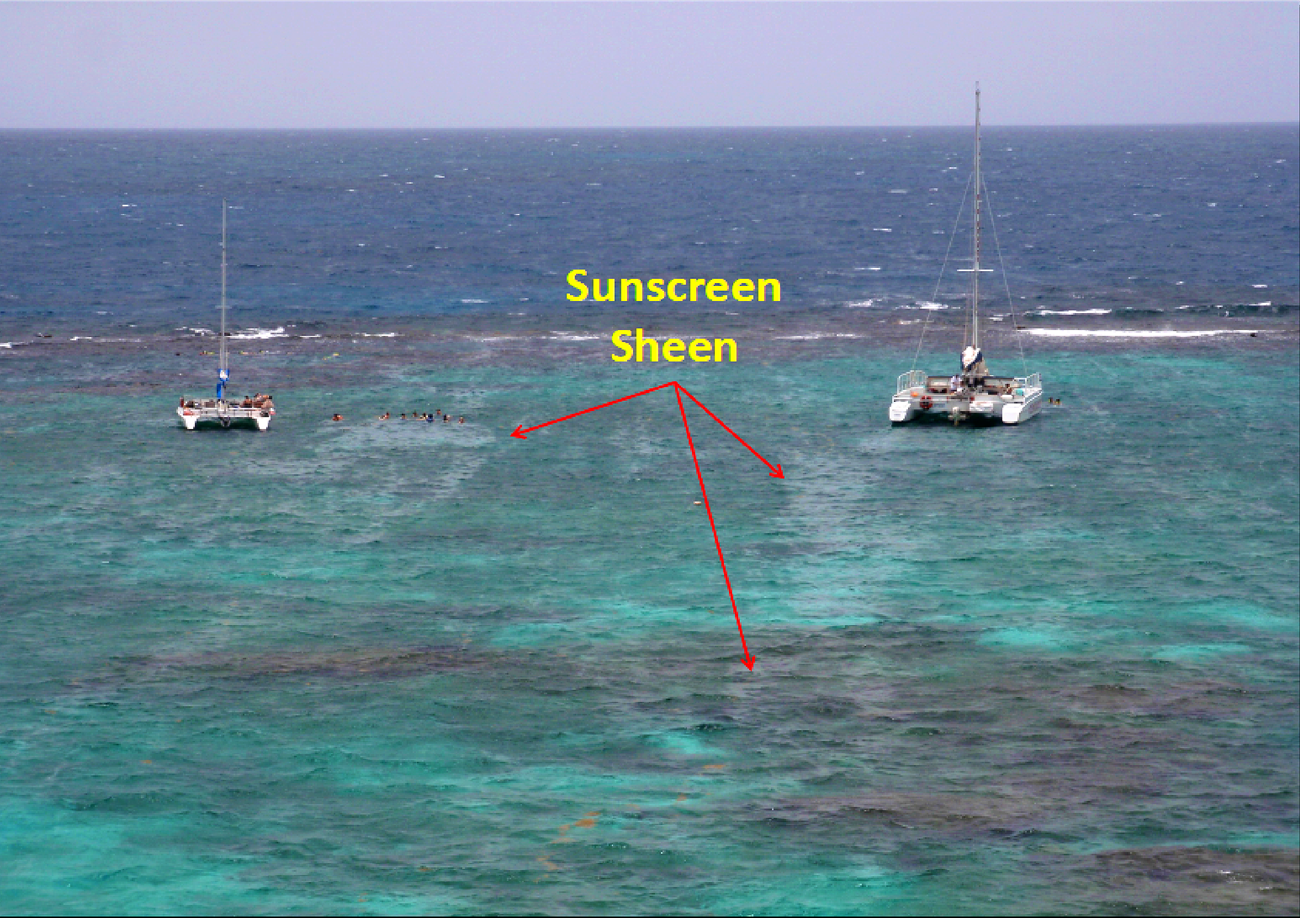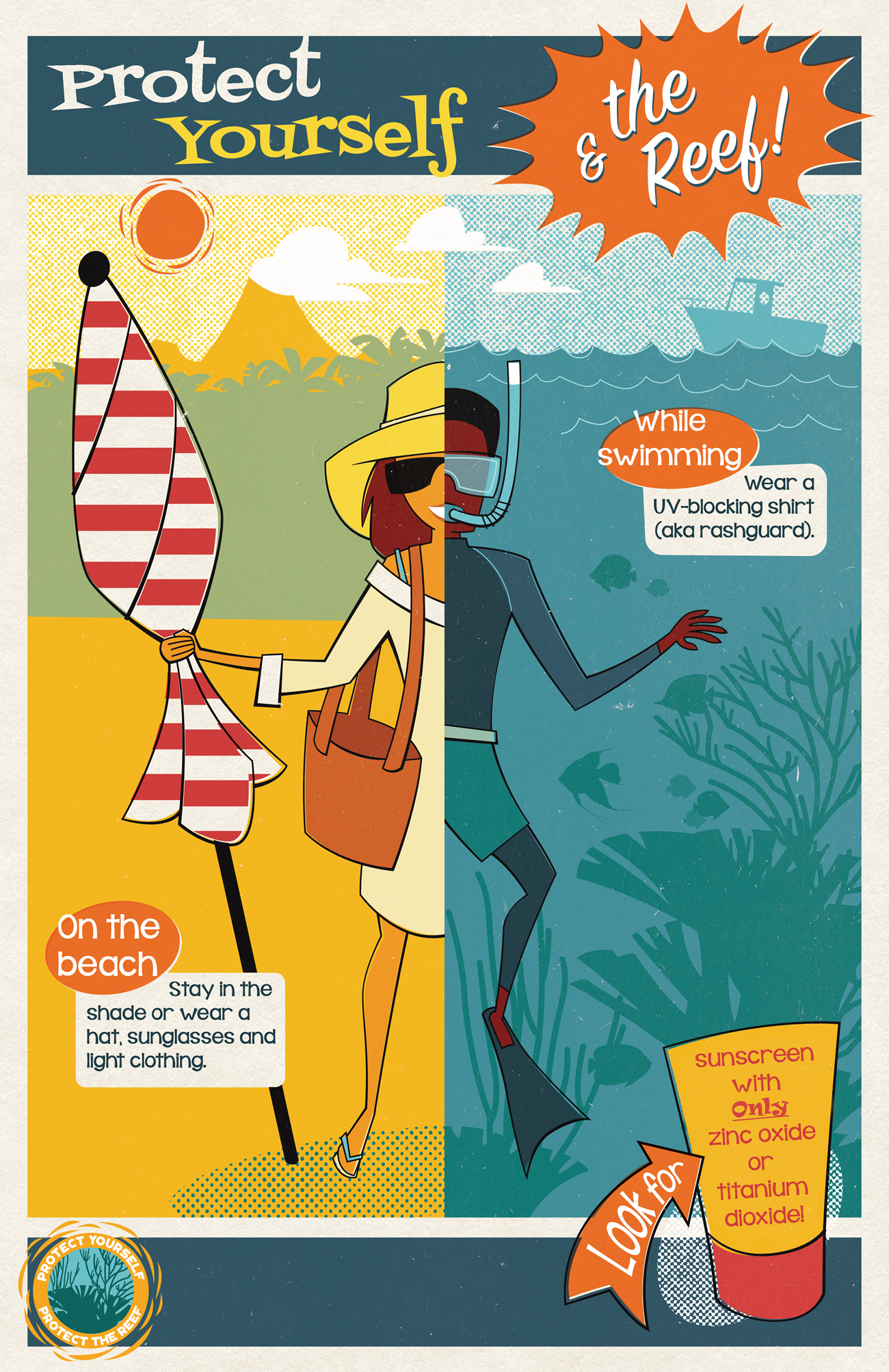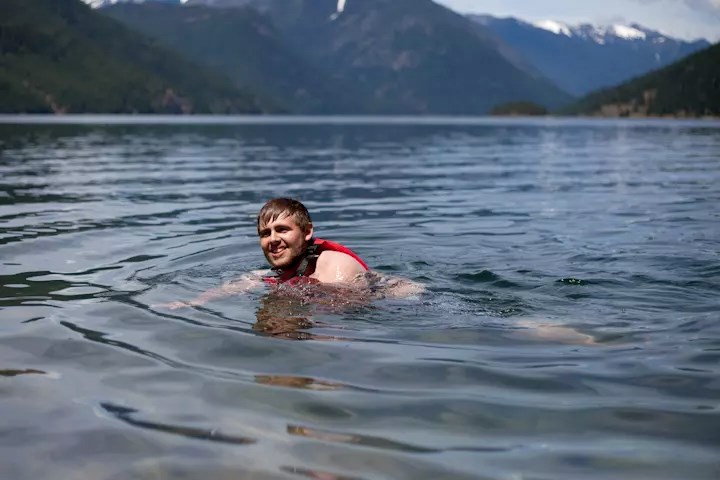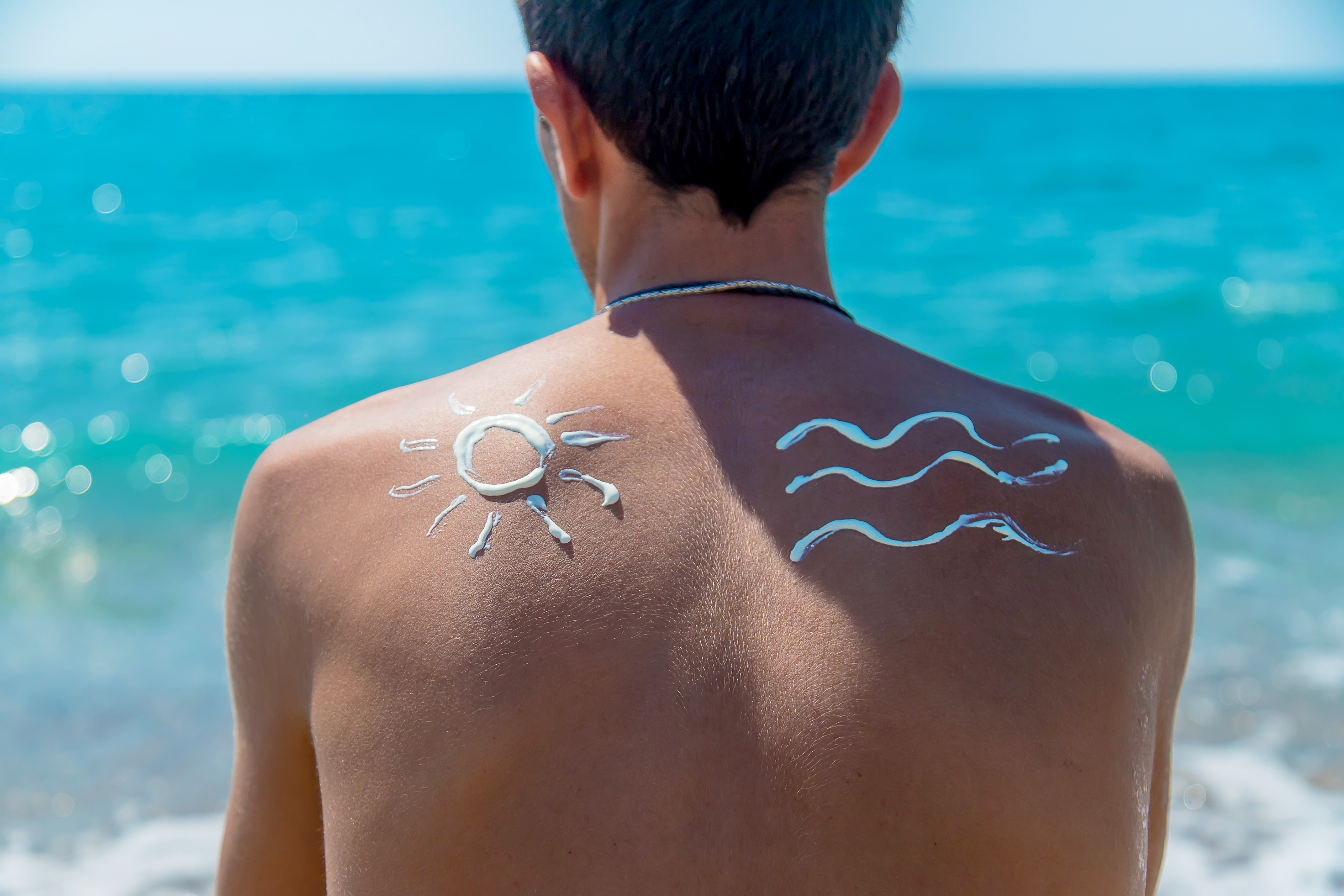Last updated: March 7, 2025
Article
New Research Shows How Parks Can Support Eco-Friendly Sunscreen Use
Sunscreens help prevent skin cancer, but some can harm the environment. Three recent behavioral science papers describe ways to boost visitors’ use of eco-friendly sun protection. That way, national park visitors can protect themselves and the places they care about too.
By Sara Melena and Eva DiDonato
Image credit: NPS
In 2010, Cheryl Woodley, a researcher with the National Oceanic and Atmospheric Administration, shared her concerns about sunscreens with Anna Toline, a National Park Service marine scientist.
A growing body of work was indicating that certain chemicals in sunscreens had the potential to harm corals. A biologist working at Virgin Islands National Park had sent a picture to Toline of a strange sheen on the water surrounding swimmers in Trunk Bay, a popular snorkeling spot in the park. Every day, park visitors slathered themselves in sunscreen, as the CDC recommends, before jumping into the water. The sheen was visible evidence that sunscreen was washing off into the water. Toline thought, “This can’t possibly be good.”

Image credit: NPS / Tony Pernas
Climate change, pollution, marine debris, invasive species, ocean acidification, and disease already threatened the survival of coral reefs. Toline realized the toxic chemicals used in some sunscreens could make a tough situation worse. She collaborated with park staff to carry out a public campaign to raise awareness about the impacts of certain sunscreen chemicals on corals. Meanwhile, on the Pacific side, U.S. national parks in Hawaii, Guam, and American Samoa also began tackling this issue.
Relying on people to make choices based on awareness and information alone assumes that if people know more or care more, they will make different decisions.
National Park Service marine ecologist Eva DiDonato wanted to help more parks communicate about how sunscreen can harm aquatic life. Parks had been educating visitors about the impacts of sunscreens with harmful chemicals on coral reefs and ways that visitors can protect corals and themselves. But relying on people to make choices based on awareness and information alone assumes that if people know more or care more, they will make different decisions. Plenty of research suggests that people don’t necessarily make better choices based on information alone. DiDonato and I (Melena) decided to take a different approach and look at this problem through the lens of behavioral science. If we could get people to change their behaviors around sunscreen, we may be able to better protect park resources.

Image credit: NPS
Along with National Park Service staff who were already working on this issue, we teamed up with social and behavioral scientists to identify barriers to choosing environmentally friendly sun protection and ways to overcome them. K.L. Akerlof, an assistant professor in science communication at George Mason University, led the project. The team included Ideas42, a behavioral design organization, and Craig Downs, an environmental ecotoxicologist who has been studying the effects of sunscreen on corals. Together, we developed approaches that parks can take to support visitors’ ability to choose ocean-friendly sun protection.
Many Influences on Human Behavior
“Behavioral design starts from an understanding that human behavior is shaped by a myriad of factors,” said project team member Maya Faulstich-Hon, “and only one of them is availability of information…so when we explore through behavioral design, we're able to explore all of the different levers that exist that influence human behavior.” Our friends influence us. Where stores place sunscreens on the shelf influence us, as do cost, smell, brand preference, and the product we chose the last time we bought sunscreen. It’s “a more empathetic approach to better understanding all of the different influences on behavior, and then designing with those specifically in mind,” Faulstich-Hon said.

Image credit: Jacob Lund - stock.adobe.com
“If the desired behavior is such a good idea, why aren’t people already doing it?”
Faulstich-Hon is a member of Ideas42, a partner in our study. Ideas42 is a nonprofit organization founded by MIT, Harvard, and Princeton universities that uses behavioral science to help people make choices. The organization’s approach to behavioral design begins by diagnosing the problem and asking the question, “If the desired behavior is such a good idea, why aren’t people already doing it?” To find answers, Ideas42 reviewed scientific literature about what might influence people’s sun protection choices. Then National Park Service staff and park partners attempted to answer that question too.
Behavioral Barriers and How to Overcome Them
As described in a paper published in December 2023 in the journal, Coastal Management, the study team identified barriers to using environmentally friendly sun protection and grouped them into four categories, along with solutions to help people overcome those barriers:
Barrier Type 1. Information Is Too Complex
When people walk down a store aisle with sunscreens, they’ll encounter a wide array of choices. If they look at the label of active ingredients, those ingredients will probably be unfamiliar. Shoppers might be left wondering which sunscreen to choose. A sunscreen with a “reef-safe” label may seem like a great choice, but “reef-safe” is an unregulated term and could be misleading.
Solutions
To overcome these barriers, parks can convey simple information about sun protection options. They can tell people to look for mineral-based sunscreen with only zinc oxide or titanium dioxide as the active ingredient, rather than what ingredients to avoid.

Image credit: NPS / Michael Warner
Barrier Type 2. Social Norms Don’t Support Desired Behavior
People look to people around them to determine what behavior is appropriate; just talk to an American middle school student if you want to know how strongly social approval can shape behavior. Some sun protection behaviors are visible, like covering up and wearing a hat. But it’s hard to know what ingredients are in someone’s sunscreen without asking.
Solutions
When social norms aren’t visible or few people are doing the desired behavior, highlighting how things are changing can be a solution. For example, pledges can make the changing norm more visible.
Barrier Type 3. Lack of Information at Decision Time
When people prepare for a trip to the beach or lakeshore, a new bottle of sunscreen is probably high on their list. At the store, there are many options to consider when selecting sunscreen: sun protection factor (SPF), water resistance, fragrance, feel, ingredients, price, and brand. The easiest thing for people to do is to buy what they always buy (habit) and move on. Then, when they arrive at their destination and discover what they bought isn’t good for the environment (or is banned!), they’ve already made a financial commitment and it’s tough to throw it away and buy something new.

Image credit: NPS / Michael Warner
Solutions
Parks can help visitors make a better choice the next time they buy sunscreen. This can include distributing wallet cards with information about what to look for. Or installing sunscreen pumps so that visitors can take immediate action if they didn’t bring an environmentally friendly sunscreen. Sunscreen exchanges are another way to help visitors make an eco-friendly decision the next time they purchase sun protection. Kaloko-Honokōhau National Historical Park gives visitors environmentally friendly products in exchange for what they have. The replacement sunscreen serves as a prompt for what to buy next time.

Image credit: courtesy of Dr. K.L. Akerlof
Barrier Type 4. What Happens in One Location Stays There
How someone acts on vacation may not be the same as how they act at home, because the social, legal, and physical contexts are different. Sun protection campaigns, for example, can have greater effect on people engaging in waterside recreation than on their everyday activities. Bans are external motivators tied to a specific location. If a vacation spot is very different than home, it may not be obvious that messaging about corals could apply to other aquatic systems like lakes and rivers.
Solutions
To reduce these barriers, parks can offer visitors opportunities that help them see themselves as environmental stewards. Parks can also showcase that sunscreen choices are relevant to other locations. For example, displays can show different locations where the issue is relevant. A map of pledges can show how people anywhere can choose to use mineral sunscreens and cover up.

Image credit: NPS / Karlie Roland
Knowing Your Audience
Parks benefit most from behavioral solutions if they focus on visitor groups or audiences that have the greatest impact on park resources or are most receptive to change. As explained in our November 2023 paper in the journal Marine Policy, to understand who these are, we surveyed visitors at two national parks with marine ecosystems: Kaloko-Honokōhau National Historical Park in Hawai‘i and Cape Lookout National Seashore in North Carolina. Both parks offer visitors great opportunities to enjoy the beach, recreate in the water, and see wildlife.
Survey respondents wanted to take actions to protect oceans. But most were using sunscreens with environmentally harmful chemicals.
Kaloko-Honokōhau has been raising awareness about the impacts of sunscreen on corals for more than a decade. In 2018, the State of Hawai‘i instituted a prohibition on the sale of sunscreens containing oxybenzone and octinoxate. At Cape Lookout, a park with seagrass habitat and lots of water recreation, staff shared information with visitors about protection from the sun’s ultraviolet rays but not about the potential for sunscreen to harm aquatic life.
We used the surveys to learn how aware visitors were about sunscreen’s environmental impacts and what type of product they used. We also asked about what they would do on their next visit after learning about the risks of non-mineral sunscreens. Survey respondents wanted to take actions to protect oceans, which means parks may not need to spend a lot of time explaining the issue or why people should care. But most respondents were using sunscreens with environmentally harmful chemicals, regardless of local prohibitions. Instead, we could support visitors’ abilities to choose less harmful sun protection for their next park visit.

Image credit: NPS / Kerby Price
Identifying Visitors with the Greatest Impact
Using the survey results, we characterized our target audiences. We looked at whether visitors were local residents or tourists, how often they visited the park, their reasons for visiting, and whether the National Park Service had told them about using mineral sunscreen and covering up. We assessed how these characteristics related to visitors’ stated likelihood of wearing mineral sunscreen or covering up on their next visit. We also examined how audiences differed demographically.
For all groups that use sunscreen, the recommended strategy is to reach them before they visit the park.
As described in our May 2023 paper in the journal, Risk Analysis, we identified four audience groups from these survey results. The groups differed in their issue awareness, perceptions of sunscreens’ risk to the environment, and type of sun protection they intended to use during their next visit. We found that the audience group most likely to introduce harmful sunscreen chemicals to the park environment was the youngest (half were 18–34 years old). These visitors used non-mineral sunscreen as their primary form of sun protection. Compared to other groups, they were less likely to live in the state where the park was located or be frequent beachgoers.
Compared to other groups, these visitors were less aware of the harm some sunscreens could cause. The challenge for parks is to reach them before they develop strong habits and preferences for sun protection. For all groups that use sunscreen, the recommended strategy is to reach them before they visit the park.
How to Be Sunscreen Savvy
Tip No. 1: Protect Yourself.
Apply sun protection when you know you'll be out in the sun. Be thorough when you apply it (no gaps). This will help avoid painful sunburns or even sun poisoning. It can reduce your risk of melanoma and other skin cancers. Don't forget places like ears, eyelids, lips and feet!
Tip No. 2: Know the Difference.
Mineral sunscreen, also called organic or physical sunscreen, has minerals that protect your skin by reflecting UV light from the sun. On the back of a mineral sunscreen bottle, you’ll see active ingredients like these:
- Zinc oxide
- Titanium dioxide
These ingredients act like a shield from the sun's rays. Instead of being absorbed into your skin, mineral sunscreen sits on the surface, reflecting and scattering UV rays away. Mineral sunscreen has a thicker texture compared to chemical sunscreens. It's usually opaque and begins working right away.

Image credit: yanadjan - stock.adobe.com
Chemical sunscreen has chemicals that absorb the sun’s rays, keeping them from reaching your skin. It has active ingredients like these:
- Avobenzone
- Oxybenzone
- Octinoxate
These chemicals act like a sponge, soaking up UV rays and converting them into heat, which is then released from your skin. Chemical sunscreen usually looks clear, and your skin has to have time to absorb it for it to work.
Information adapted from "The Difference Between Mineral and Chemical Sunscreens," clevelandclinic.org.
Beyond Sunscreen
Our work focused primarily on visitor behavior and sunscreen use in marine parks, but sunscreen chemicals can harm other aquatic ecosystems, like freshwater rivers and lakes. The solutions we developed can be adapted to different situations by following a process similar to ours, beginning with the question, “If doing the desired action is such a good idea, why aren’t people doing it here?” Based on the answer to that question, parks can create solutions to help visitors overcome barriers to change. As we did, they can use localized surveys to design their approach, or they can use literature reviews and local expertise.
Incorporating behavioral science strategies when designing conservation campaigns can be a smart way to further support park stewardship and positive visitor experiences.
Our behavioral science methods can also be applied to a broad range of other conservation issues to guide people to take specific actions to protect parks, wildlife, and the environment. A few examples are encouraging safe wildlife viewing distances, preventing the spread of aquatic invasive species, and improving management of free-ranging cats.
Psychologist P. Wesley Schultz once wrote, “Conservation is a goal that can only be achieved by changing behavior.” The National Park Service uses communication, education, and interpretation to share the work we do and to connect people to parks. The countless numbers of people devoted to national parks and their conservation are a testament to the success of this work. But regardless of whether or not you agree with Schultz, incorporating behavioral science strategies when designing conservation campaigns can be a smart way to further support park stewardship and positive visitor experiences.

Sara Melena is a communication specialist with the National Park Service’s Natural Resource Office of Communications. Image credit: courtesy of Sara Melena.

Eva DiDonato is the program lead of the National Park Service Ocean and Coastal Resources Program, Water Resources Division. Image credit: courtesy of Eva DiDonato.
